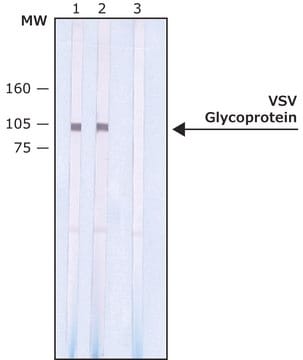An essential product for immunoprecipitations of VSV-tagged recombinant proteins. Given the packaging of the product, we aliquoted it into microfuge tubes on arrival and stored it at 4 C.
A1970
Anti-VSV-Glycoprotein−Agarose antibody, Mouse monoclonal
clone P5D4, purified from hybridoma cell culture, PBS suspension
Sinónimos:
Monoclonal Anti-VSV Glycoprotein
About This Item
Productos recomendados
origen biológico
mouse
conjugado
agarose conjugate
forma del anticuerpo
purified immunoglobulin
tipo de anticuerpo
primary antibodies
clon
P5D4, monoclonal
Formulario
PBS suspension
clases químicas de analitos
proteins (VSV-G)
técnicas
immunoprecipitation (IP): suitable
protein purification: suitable
isotipo
IgG1
capacidad
≥15 nmol/mL, resin binding capacity (VSV-G tagged fusion protein)
Condiciones de envío
wet ice
temp. de almacenamiento
2-8°C
¿Está buscando productos similares? Visita Guía de comparación de productos
Descripción general
Especificidad
Inmunógeno
Aplicación
Immunoprecipitation (1 paper)
Forma física
Nota de preparación
¿No encuentra el producto adecuado?
Pruebe nuestro Herramienta de selección de productos.
Código de clase de almacenamiento
10 - Combustible liquids
Clase de riesgo para el agua (WGK)
nwg
Punto de inflamabilidad (°F)
Not applicable
Punto de inflamabilidad (°C)
Not applicable
Elija entre una de las versiones más recientes:
Certificados de análisis (COA)
¿No ve la versión correcta?
Si necesita una versión concreta, puede buscar un certificado específico por el número de lote.
¿Ya tiene este producto?
Encuentre la documentación para los productos que ha comprado recientemente en la Biblioteca de documentos.
Active Filters
Nuestro equipo de científicos tiene experiencia en todas las áreas de investigación: Ciencias de la vida, Ciencia de los materiales, Síntesis química, Cromatografía, Analítica y muchas otras.
Póngase en contacto con el Servicio técnico







